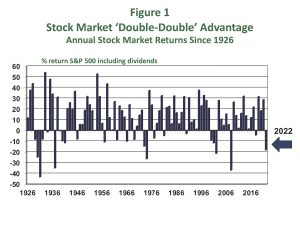The S&P 500 lost 18.11% during 2022, when you include the return from dividends. If you’re retired or soon-to-be retired, should this development be a cause for concern?
You might not have reasons to be worried if you implemented a strategy that prevents you from experiencing life-changing losses and if you can maintain a positive perspective based on historical experience. Let’s start with the historical perspective.
Most of the time the stock market has earned positive returns
Figure 1 in the chart below shows the annual return in the S&P 500 since 1926, including the return from dividends. This chart provides a picture of the following conclusion: Most of the time, but not always, you’ll earn more money by remaining invested in the stock market.

The numbers confirm the stock market “double-double” advantage:
- There are far more years of positive returns than negative returns—the score is 71 years to 26 years.
- The arithmetic average gain in positive years is much more than the average loss in negative years. The score is a positive average return of 21.3%, compared to a negative average loss of 13.4%.
The chart also shows that if you decide to invest in the stock market during your retirement, you should be prepared for some years of negative returns. Historically, however, if you were patient and stayed invested, the market eventually bounced back and you most likely would have experienced a net gain, which was often quite significant.
The key is to have a strategy that keeps you invested during downturns, which we’ll discuss next.
Have a strategy to remain invested during market crashes
Most people—professionals and amateurs alike—don’t have a reliable crystal ball that warns them when the stock market will drop or alerts them when the market is about to take off. Once that realization sinks in, you might conclude that it’s a good idea to invest in the stock market to earn more over the long term and have a strategy to ride out the downturns.
Here are two strategies to help pre-retirees and retirees ride out the downturns that are supported by research I’ve conducted at the Stanford Center on Longevity:
- Have enough regular retirement income that won’t go down if the stock market crashes. How much is “enough”? The amount that prevents you from panicking and selling your investments when the stock market’s dropping. One possibility is to cover most—if not all—of your “must have” living expenses with the guaranteed sources of retirement income. Examples of such guaranteed income include Social Security, pensions, income annuities, interest income from bonds, cashflow from a bond ladder, and withdrawals from a reverse mortgage.
- For your regular, systematic withdrawals from invested assets, be prepared to reduce your withdrawals when the market is down. This can help minimize long-term losses due to sequence-of-returns risk—the risk that you withdraw so much during downturns that you don’t have sufficient assets to bounce back when the market turns up again.
One good method for implementing this second strategy is to determine the annual amount of your withdrawals by applying a percentage to the value of your remaining assets at the beginning of each year. The IRS required minimum distribution is an example of one method that research shows has worked well in the past for this purpose.
Consider the current investment climate as a test of your investment strategies during retirement. If you’ve been extremely worried during the latest stock market downturns, you might want to revisit and potentially modify your strategies.
If you aren’t nervous, congratulations, but don’t get too complacent. You’ll want to continue monitoring your investments and sources of retirement income to make sure you have sufficient income to live the life you want in retirement, no matter what happens in the stock market. It’s a very good use of your time.

